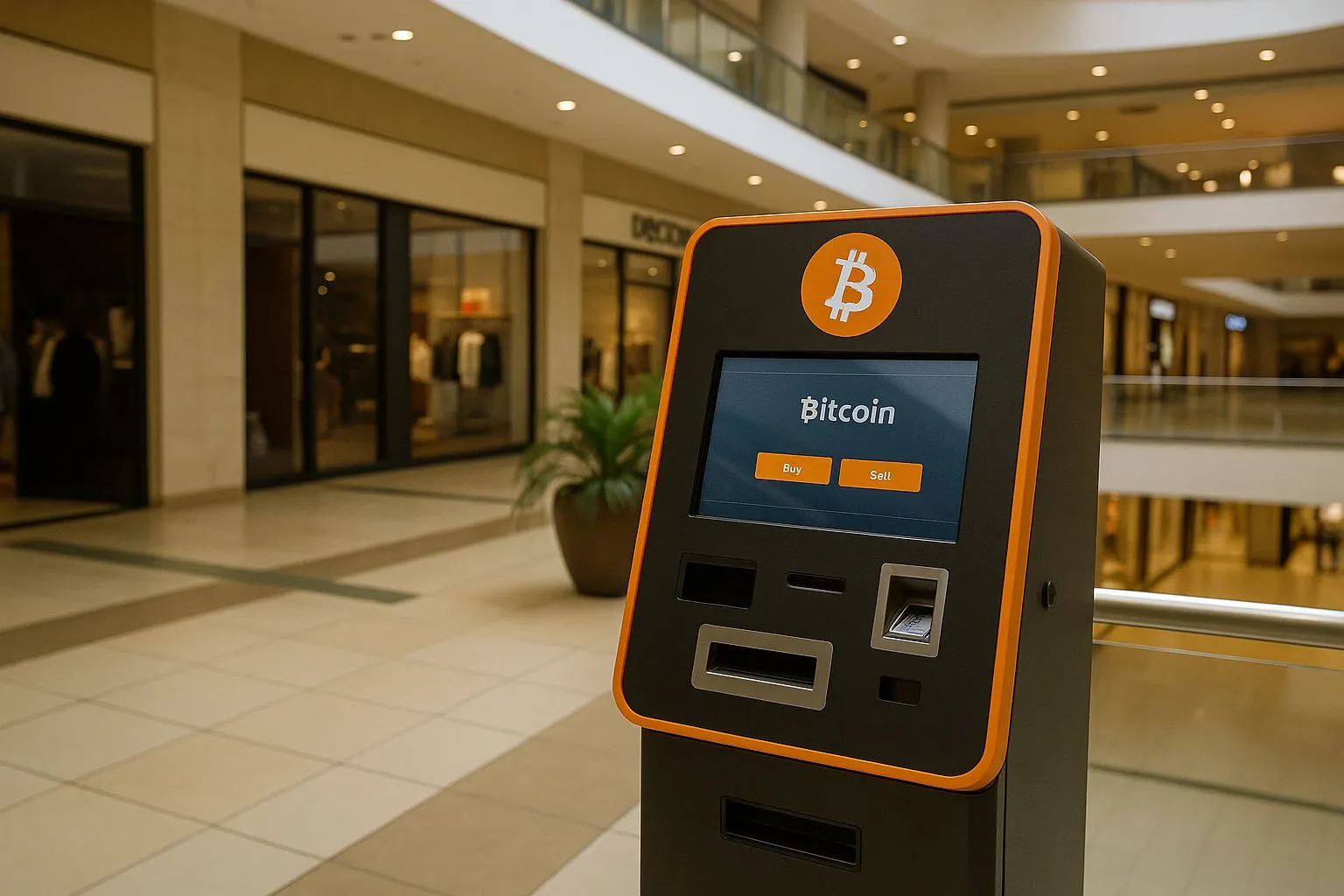Kenya’s ambitious attempt to regulate its burgeoning cryptocurrency sector has encountered an immediate and highly visible challenge. Just days after implementing the country’s first comprehensive Virtual Assets Service Providers Act of 2025, Bitcoin ATMs branded “Bankless Bitcoin” appeared in several major shopping malls across Nairobi, as reported by Capital Fm creating an awkward confrontation between the nation’s formal regulatory framework and the practical realities of crypto adoption on the ground.
The timing could not be more conspicuous. These gleaming machines, installed beside traditional banking kiosks in upscale retail environments, represent the physical manifestation of cryptocurrency moving from Kenya’s informal economy into mainstream commercial spaces—precisely as regulators insist that no crypto service provider has yet received authorization to operate legally within the country.
Build the future you deserve. Get started with our top-tier Online courses: ACCA, HESI A2, ATI TEAS 7, HESI EXIT, NCLEX-RN, NCLEX-PN, and Financial Literacy. Let Serrari Ed guide your path to success. Enroll today.
The Regulatory Landscape: Kenya’s First Crypto Law Takes Effect
On November 4, 2025, Kenya became one of the first African nations to implement a comprehensive licensing framework specifically designed for cryptocurrency businesses. The Virtual Assets Service Providers Act establishes a dual regulatory structure that assigns oversight responsibilities based on the specific functions crypto companies perform.
Under this framework, the Central Bank of Kenya (CBK) assumes responsibility for overseeing payment systems and custody functions—essentially regulating how crypto businesses handle customer funds and facilitate transfers. Meanwhile, the Capital Markets Authority (CMA) receives jurisdiction over investment and trading activities, including exchanges where Kenyans buy, sell, and speculate on digital assets.
This bifurcated regulatory approach reflects sophisticated understanding of how modern cryptocurrency businesses operate. Unlike traditional financial institutions that typically fall clearly under either banking or securities regulation, crypto platforms often perform hybrid functions that blur these traditional boundaries. A single platform might offer wallet custody services (traditionally banking), facilitate peer-to-peer transfers (payment services), and provide trading venues (securities functions). Kenya’s dual-regulator model attempts to address this complexity by assigning oversight based on specific activities rather than forcing crypto businesses into ill-fitting regulatory categories.
The legislation represents years of policy development and consultation with industry stakeholders, positioning Kenya as a potential leader in African cryptocurrency regulation. The continent has emerged as one of the world’s fastest-growing cryptocurrency markets, with grassroots adoption driven by practical use cases including cross-border remittances, protection against currency devaluation, and access to financial services for unbanked populations.
The Regulatory Gap: Law Without Implementation Framework
However, Kenya’s new crypto law faces a fundamental problem that creates space for the current confusion: while the Act itself is legally in force, the specific regulations required to actually begin licensing Virtual Assets Service Providers have not yet been issued. This creates a peculiar legal limbo where cryptocurrency businesses cannot obtain licenses because the licensing process doesn’t yet exist, yet the law formally regulates an industry that technically should not be operating without authorization.
In a joint notice issued on November 19, 2025, the Central Bank of Kenya and Capital Markets Authority addressed this situation directly, warning the Kenyan public that no Virtual Assets Service Provider has received authorization to operate:
“Currently, CBK and CMA have not licensed any VASPs under the Act to operate in or from Kenya,” the regulators stated unequivocally. The notice continued by cautioning that any companies claiming authorization are operating illegally and that consumers should exercise extreme caution when dealing with such entities.
The regulators explained that the National Treasury is currently developing the implementing regulations that will establish the actual licensing procedures, application requirements, compliance standards, and operational guidelines crypto businesses must meet. Until these regulations are published and take effect, the licensing framework exists only in theory rather than practice.
This transitional period creates significant uncertainty for both crypto businesses attempting to operate compliantly and consumers trying to determine which services are legitimate. The situation parallels challenges other jurisdictions have faced when implementing cryptocurrency regulation, where the gap between legislative intent and operational implementation creates opportunities for both confusion and potential exploitation.
Bitcoin ATMs: From Concept to Controversial Reality
The appearance of Bitcoin ATMs in Nairobi’s shopping malls represents more than just another technology deployment—it marks cryptocurrency’s arrival in Kenya’s mainstream commercial spaces in a form impossible for regulators and the general public to ignore. Unlike mobile apps or online platforms that operate largely invisibly, physical ATMs occupy retail real estate, require electrical power and internet connectivity, and present themselves prominently to thousands of daily mall visitors.
According to Capital News, several major malls across Nairobi now host machines branded “Bankless Bitcoin,” positioned strategically beside traditional banking kiosks. These devices offer cash-to-crypto conversion services, allowing Kenyans to insert physical currency and receive Bitcoin transferred to their digital wallets. The reverse functionality—converting Bitcoin to Kenyan shillings—may also be available, though specific capabilities vary by machine and operator.
The installations create a jarring juxtaposition: on one side, traditional banks operating under comprehensive regulatory oversight accumulated over decades; on the other, cryptocurrency kiosks operating in what regulators explicitly characterize as an unauthorized capacity. For average mall visitors unfamiliar with the nuances of Kenya’s evolving crypto regulatory framework, the physical proximity might suggest equivalent regulatory status and consumer protections—an impression the Central Bank and Capital Markets Authority clearly wish to dispel.
Kenya’s Bitcoin ATM History: Not the First Rodeo
While the current wave of Bitcoin ATM installations is garnering significant attention, this is not Kenya’s first encounter with cryptocurrency vending machines. In 2018, The East African reported that BitClub, a now-defunct crypto provider, installed Bitcoin ATMs in Nairobi. However, that earlier experiment failed to achieve meaningful traction. Adoption remained minimal, the devices never reached mainstream retail environments, and the initiative quietly faded from public consciousness.
The contrast between 2018’s failed deployment and 2025’s prominent mall installations reflects broader changes in Kenya’s cryptocurrency ecosystem. Seven years ago, Bitcoin awareness was limited largely to technology enthusiasts and early adopters. Regulatory frameworks were nonexistent. Public understanding of cryptocurrency remained minimal. Infrastructure for buying, selling, and using digital assets was rudimentary at best.
By 2025, the landscape has transformed dramatically. According to Chainalysis research, Kenya consistently ranks among the top nations globally for cryptocurrency adoption. Mobile money infrastructure pioneered by services like M-Pesa has created cultural comfort with digital financial services that translates readily to cryptocurrency adoption. Economic pressures including inflation and currency volatility have driven practical demand for alternative stores of value. A maturing ecosystem of exchanges, wallet providers, and merchant acceptance has made cryptocurrency genuinely useful for everyday transactions.
Data from CoinATMradar, which tracks cryptocurrency ATM deployments globally, indicates only two reported Bitcoin ATMs currently registered in Kenya. However, this number may not reflect the complete picture, as informal or newly installed machines may not yet appear in international databases. The gap between officially reported machines and those visibly present in Nairobi malls suggests either incomplete data collection or machines operating deliberately outside formal tracking systems.
One decision can change your entire career. Take that step with our Online courses in ACCA, HESI A2, ATI TEAS 7, HESI EXIT, NCLEX-RN, NCLEX-PN, and Financial Literacy. Join Serrari Ed and start building your brighter future today.
The Enforcement Question: Regulatory Warnings Versus Ground Reality
The simultaneous emergence of Bitcoin ATMs and regulatory warnings creates a fundamental question: how will Kenya’s authorities enforce compliance with the new Virtual Assets Service Providers Act?
Regulatory frameworks only function effectively when backed by credible enforcement mechanisms. Laws on paper mean little if violators face no meaningful consequences. Yet enforcement presents particular challenges in cryptocurrency contexts due to several factors:
Physical Versus Digital Operations: While Bitcoin ATMs are physically present and therefore potentially easier to regulate—authorities can physically remove machines or arrest operators—much cryptocurrency activity occurs purely digitally through mobile apps and websites that may be hosted internationally. Enforcement against purely digital operators requires different tools and often international cooperation.
Jurisdiction Challenges: Cryptocurrency’s borderless nature creates enforcement complexity. If a Bitcoin ATM operator is based outside Kenya but serves Kenyan customers, which nation’s laws apply? What mechanisms exist for cross-border enforcement cooperation? These questions, common across global cryptocurrency regulation, have no simple answers.
Resource Constraints: Effective regulation requires significant regulatory capacity including technical expertise, surveillance systems, investigation capabilities, and legal frameworks for enforcement actions. Developing economies often struggle to allocate sufficient resources to specialized regulatory functions, particularly for emerging technology sectors.
Political Will: Enforcement also requires sustained political commitment. If cryptocurrency regulations prove unpopular with influential constituencies or enforcement efforts face political backlash, regulatory agencies may find themselves unable to pursue aggressive compliance actions regardless of legal authority.
The Central Bank of Kenya and Capital Markets Authority’s joint warning suggests awareness of unauthorized operations and intent to address them. However, the warning itself raises questions: if regulators know Bitcoin ATMs are operating without authorization, why have they not already taken enforcement actions to remove them? Is the warning itself the enforcement strategy, hoping operators will voluntarily cease operations? Or are more direct interventions being planned but not yet implemented?
From Kibera to Upscale Malls: Kenya’s Evolving Crypto Geography
The appearance of Bitcoin ATMs in high-end Nairobi shopping centers represents a significant geographical and socioeconomic shift in Kenya’s cryptocurrency ecosystem. While policy discussions often focus on regulatory frameworks and institutional adoption, grassroots cryptocurrency use has flourished for years in lower-income neighborhoods where formal financial services remain inadequate or inaccessible.
Capital News reporting highlights that Bitcoin usage has taken firm root in communities like Kibera, one of Africa’s largest informal settlements. In these contexts, cryptocurrency adoption is driven not by speculative investment or technological enthusiasm but by desperate practical need.
“In many cases, people in Kibera do not have an opportunity to secure their lives with normal savings,” explains Ronnie Mdawida, co-founder of AfriBit Africa, a local cryptocurrency education initiative. Traditional banking systems impose requirements—minimum balances, identification documents, proof of address, transaction fees—that effectively exclude many low-income Kenyans from formal financial services.
For someone living on approximately one dollar per day, as many Kibera residents do, these barriers are insurmountable. Banks are not designed to serve this demographic; the costs of account maintenance exceed any profit margins banks could earn from such customers. This creates a vicious cycle where those most in need of safe savings and payment mechanisms have least access to them.
Bitcoin and other cryptocurrencies offer an alternative that requires only a mobile phone and internet connection—both increasingly ubiquitous even in informal settlements. “With Bitcoin, residents can hold value without documentation and banking paperwork,” Mdawida notes, describing this as “financial freedom” for populations systematically excluded from conventional finance.
This grassroots adoption pattern, often called financial inclusion through cryptocurrency, presents a stark contrast to the speculative investment narratives that dominate cryptocurrency discourse in wealthy nations. In Kibera, Bitcoin is not about getting rich quick or disrupting traditional finance as an ideological project—it’s about having any secure place to save money at all.
The migration of Bitcoin ATMs from informal neighborhood networks into upscale mall spaces signals that cryptocurrency is transcending its origins in financially excluded communities and entering mainstream commercial infrastructure. This transition from necessity-driven grassroots adoption to broader mainstream acceptance represents a pivotal moment in Kenya’s crypto evolution.
Broader African Context: Kenya as Continental Cryptocurrency Leader
Kenya’s cryptocurrency journey unfolds within broader continental dynamics that position Africa as one of the world’s most dynamic crypto adoption regions. Multiple factors drive this trend:
Remittances: Africa receives over $100 billion annually in remittances, with traditional transfer mechanisms often charging exorbitant fees and imposing frustrating delays. Cryptocurrency offers faster, cheaper alternatives for cross-border money movement.
Currency Instability: Many African nations experience significant currency volatility and inflation, eroding the value of local savings. Bitcoin and stablecoins pegged to stronger currencies provide hedges against local currency depreciation.
Mobile Money Infrastructure: Africa’s pioneering mobile money systems created cultural comfort with digital financial services and built technological infrastructure cryptocurrency can leverage. Kenya’s M-Pesa alone serves over 50 million users, demonstrating massive scale digital payment adoption.
Youth Demographics: Africa has the world’s youngest population, with median ages in many nations below 20 years. Younger demographics typically show greater comfort with digital technologies and willingness to adopt innovative financial tools.
Entrepreneurship: Limited formal employment opportunities drive high levels of entrepreneurial activity, often requiring access to capital and payment mechanisms that traditional systems provide inadequately. Cryptocurrency can fill these gaps.
These factors create fertile ground for cryptocurrency adoption across the continent. According to Chainalysis’s 2024 Geography of Cryptocurrency Report, multiple African nations rank among global leaders in cryptocurrency adoption when measured relative to population and economic size.
What Happens Next: Scenarios for Resolution
Kenya’s current situation—formal regulation without implementation mechanisms, visible Bitcoin ATMs operating without authorization, regulatory warnings without apparent enforcement—cannot persist indefinitely. Several scenarios could resolve this tension:
Scenario 1: Aggressive Enforcement: Regulators could move decisively to shut down unauthorized operations, physically removing Bitcoin ATMs and pursuing legal actions against operators. This would demonstrate regulatory authority but might drive cryptocurrency activity underground and damage Kenya’s reputation as an innovation-friendly jurisdiction.
Scenario 2: Accelerated Licensing: The National Treasury could fast-track implementing regulations, allowing legitimate operators to obtain licenses quickly. Bitcoin ATM operators might then either apply for authorization or be shut down for non-compliance. This approach balances regulation with industry development but requires rapid bureaucratic action.
Scenario 3: De Facto Tolerance: Regulators might issue warnings but avoid aggressive enforcement, creating unofficial tolerance for cryptocurrency operations during the transitional period. This minimizes disruption but undermines regulatory credibility and potentially exposes consumers to risks.
Scenario 4: Legislative Revision: Policymakers might conclude that the current regulatory framework is unworkable and revise the legislation itself, potentially creating exemptions for certain activities or establishing transitional provisions that explicitly authorize operations during the implementation period.
Which scenario unfolds will depend on complex interactions between regulatory capacity, political considerations, industry lobbying, public opinion, and practical enforcement challenges. International observers will watch closely, as Kenya’s experience could inform regulatory approaches across Africa and other developing regions grappling with similar challenges.
Conclusion: Testing Ground for African Crypto Regulation
The appearance of Bitcoin ATMs in Nairobi malls immediately following implementation of Kenya’s Virtual Assets Service Providers Act creates a genuine stress test for the country’s regulatory framework. This is not merely an administrative inconvenience or minor implementation hiccup—it’s a fundamental question about whether Kenya can effectively regulate a technology designed specifically to resist centralized control.
The outcome matters far beyond Kenya’s borders. As one of Africa’s most economically significant nations and a regional technology leader, Kenya’s regulatory experience will influence policy development across the continent. Success in establishing effective, balanced cryptocurrency regulation could provide a template other African nations emulate. Failure could discourage regulatory efforts elsewhere or drive them toward excessively restrictive approaches that stifle innovation while failing to prevent illicit activity.
For now, Nairobi’s Bitcoin ATMs stand as gleaming symbols of tension between technological change and regulatory authority, between grassroots adoption and formal oversight, between Kenya’s cryptocurrency present and its uncertain regulatory future. How this tension resolves will help determine whether Kenya achieves its ambition to lead African cryptocurrency regulation or becomes a cautionary tale of regulatory frameworks that cannot keep pace with the technologies they attempt to govern.
Ready to take your career to the next level? Join our Online courses: ACCA, HESI A2, ATI TEAS 7 , HESI EXIT , NCLEX – RN and NCLEX – PN, Financial Literacy!🌟 Dive into a world of opportunities and empower yourself for success. Explore more at Serrari Ed and start your exciting journey today! ✨
Track GDP, Inflation and Central Bank rates for top African markets with Serrari’s comparator tool.
See today’s Treasury bonds and Money market funds movement across financial service providers in Kenya, using Serrari’s comparator tools.
photo source: Google
By: Montel Kamau
Serrari Financial Analyst
20th November, 2025
Article, Financial and News Disclaimer
The Value of a Financial Advisor
While this article offers valuable insights, it is essential to recognize that personal finance can be highly complex and unique to each individual. A financial advisor provides professional expertise and personalized guidance to help you make well-informed decisions tailored to your specific circumstances and goals.
Beyond offering knowledge, a financial advisor serves as a trusted partner to help you stay disciplined, avoid common pitfalls, and remain focused on your long-term objectives. Their perspective and experience can complement your own efforts, enhancing your financial well-being and ensuring a more confident approach to managing your finances.
Disclaimer: This article is for informational purposes only and does not constitute financial advice. Readers are encouraged to consult a licensed financial advisor to obtain guidance specific to their financial situation.
Article and News Disclaimer
The information provided on www.serrarigroup.com is for general informational purposes only. While we strive to keep the information up to date and accurate, we make no representations or warranties of any kind, express or implied, about the completeness, accuracy, reliability, suitability, or availability with respect to the website or the information, products, services, or related graphics contained on the website for any purpose. Any reliance you place on such information is therefore strictly at your own risk.
www.serrarigroup.com is not responsible for any errors or omissions, or for the results obtained from the use of this information. All information on the website is provided on an as-is basis, with no guarantee of completeness, accuracy, timeliness, or of the results obtained from the use of this information, and without warranty of any kind, express or implied, including but not limited to warranties of performance, merchantability, and fitness for a particular purpose.
In no event will www.serrarigroup.com be liable to you or anyone else for any decision made or action taken in reliance on the information provided on the website or for any consequential, special, or similar damages, even if advised of the possibility of such damages.
The articles, news, and information presented on www.serrarigroup.com reflect the opinions of the respective authors and contributors and do not necessarily represent the views of the website or its management. Any views or opinions expressed are solely those of the individual authors and do not represent the website's views or opinions as a whole.
The content on www.serrarigroup.com may include links to external websites, which are provided for convenience and informational purposes only. We have no control over the nature, content, and availability of those sites. The inclusion of any links does not necessarily imply a recommendation or endorsement of the views expressed within them.
Every effort is made to keep the website up and running smoothly. However, www.serrarigroup.com takes no responsibility for, and will not be liable for, the website being temporarily unavailable due to technical issues beyond our control.
Please note that laws, regulations, and information can change rapidly, and we advise you to conduct further research and seek professional advice when necessary.
By using www.serrarigroup.com, you agree to this disclaimer and its terms. If you do not agree with this disclaimer, please do not use the website.
www.serrarigroup.com, reserves the right to update, modify, or remove any part of this disclaimer without prior notice. It is your responsibility to review this disclaimer periodically for changes.
Serrari Group 2025












